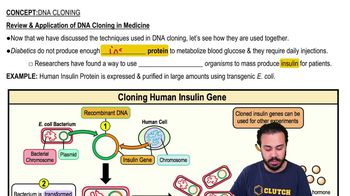Explain what qualifies the gene therapy method to cure sickle cell disease as an ex vivo approach.
 Freeman 8th Edition
Freeman 8th Edition Ch. 20 - The Molecular Revolution: Biotechnology, Genomics, and New Frontiers
Ch. 20 - The Molecular Revolution: Biotechnology, Genomics, and New Frontiers Problem 1
Problem 1Describe why biologists often generate genetically modified organisms (GMOs) for research purposes.
 Verified step by step guidance
Verified step by step guidanceKey Concepts
Genetic Modification

Research Applications

Ethical Considerations
After finding a gene that causes a disease, researchers often introduce the defective allele into mice to create an animal model of the disease. Why are these models valuable?
a. They allow the testing of potential drug therapies without endangering human patients.
b. They allow the sequencing of the mutant allele.
c. They allow the production of large quantities of the defective gene product, usually a protein.
d. They allow the study of how the gene was transmitted from parents to offspring.
The human genome size is 3 billion base pairs, and the size of the baker's yeast genome, a single-celled organism, is 12 million base pairs. Therefore, the predicted genome size for another single-celled organism, an amoeba,
a. Is about the size of the human genome
b. Is about the size of the yeast genome
c. Is somewhere between the sizes of the yeast and human genomes
d. Cannot be predicted with any certainty